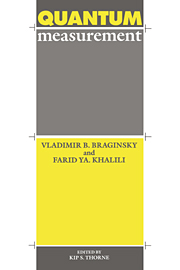Book contents
- Frontmatter
- Contents
- Dedication
- Editor's Foreword
- Notation
- Chapter I Historical introduction: photons and measurements using photons
- Chapter II The main principles of quantum mechanics
- Chapter III Indirect measurements
- Chapter IV Quantum nondemolition measurements
- Chapter V Linear measurements
- Chapter VI Continuous linear measurements
- Chapter VII Nonlinear systems for continuous measurements
- Chapter VIII Detection of classical forces
- Chapter IX Energetic quantum limitations
- Chapter X Devices for measuring small mechanical displacements
- Chapter XI Quantum nondemolition measurements of a resonator's energy
- Chapter XII Nonclassical states of electromagnetic waves as tools for quantum measurements
- Conclusion
- References
- Subject Index
Chapter VII - Nonlinear systems for continuous measurements
Published online by Cambridge University Press: 15 December 2009
- Frontmatter
- Contents
- Dedication
- Editor's Foreword
- Notation
- Chapter I Historical introduction: photons and measurements using photons
- Chapter II The main principles of quantum mechanics
- Chapter III Indirect measurements
- Chapter IV Quantum nondemolition measurements
- Chapter V Linear measurements
- Chapter VI Continuous linear measurements
- Chapter VII Nonlinear systems for continuous measurements
- Chapter VIII Detection of classical forces
- Chapter IX Energetic quantum limitations
- Chapter X Devices for measuring small mechanical displacements
- Chapter XI Quantum nondemolition measurements of a resonator's energy
- Chapter XII Nonclassical states of electromagnetic waves as tools for quantum measurements
- Conclusion
- References
- Subject Index
Summary
Fluctuational and dynamical back action of the measuring device
During a continuous monitoring of a quantum object, the measuring device can act back on the object in general in two different ways: First, it can influence the evolution of the expectation value of the measured observables. This is called the “dynamical back action,” and it is a regular, predictable effect. (An example is the dynamical back action produced by the dynamical rigidity of a capacity sensor, which will be discussed in chapter X.) Second, the measuring device can perturb the observables in a random way, increasing their uncertainties, i.e. producing random deviations from their expectation values. A key feature of linear, continuous measurements, as discussed in the last chapter, is that for them these two types of back action are completely independent. The fluctuational back action is fundamental and irremovable, while the dynamical back action can be avoided entirely by a suitable construction of the measuring device.
For nonlinear systems the situation is completely different, as one can readily see from a typical example of a nonlinear, continuous measurement: a monitoring of an oscillator's energy. In accord with the uncertainty relation, the energy measurement produces perturbations of the oscillator's phase, and as the measurement proceeds continuously, these perturbations cause the phase to diffuse in a Brownian-motion type way.
- Type
- Chapter
- Information
- Quantum Measurement , pp. 93 - 104Publisher: Cambridge University PressPrint publication year: 1992



